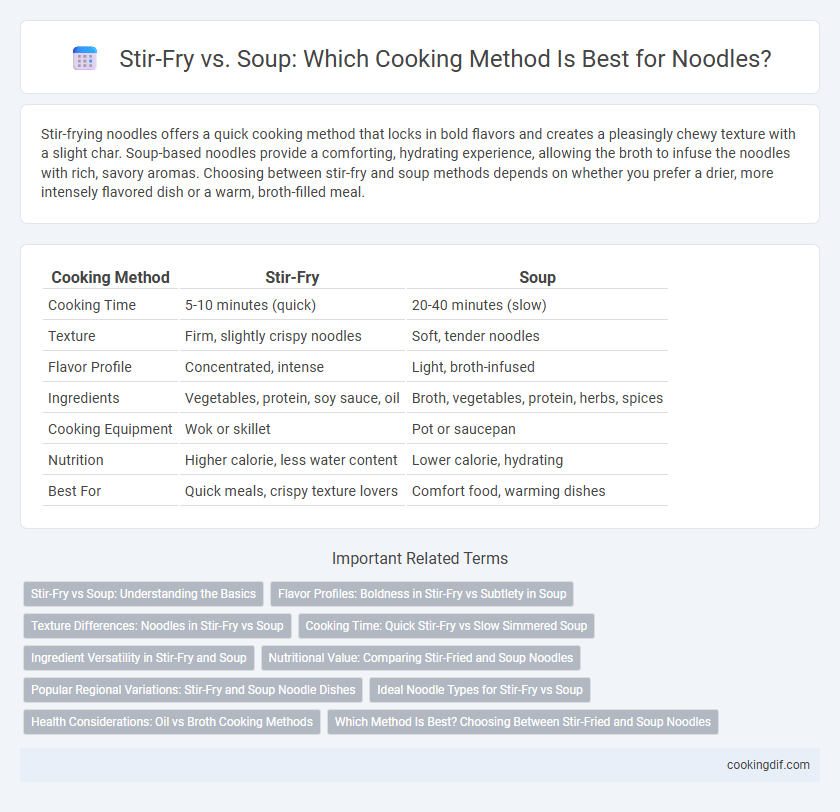Stir-frying noodles offers a quick cooking method that locks in bold flavors and creates a pleasingly chewy texture with a slight char. Soup-based noodles provide a comforting, hydrating experience, allowing the broth to infuse the noodles with rich, savory aromas. Choosing between stir-fry and soup methods depends on whether you prefer a drier, more intensely flavored dish or a warm, broth-filled meal.
Table of Comparison
| Cooking Method | Stir-Fry | Soup |
|---|---|---|
| Cooking Time | 5-10 minutes (quick) | 20-40 minutes (slow) |
| Texture | Firm, slightly crispy noodles | Soft, tender noodles |
| Flavor Profile | Concentrated, intense | Light, broth-infused |
| Ingredients | Vegetables, protein, soy sauce, oil | Broth, vegetables, protein, herbs, spices |
| Cooking Equipment | Wok or skillet | Pot or saucepan |
| Nutrition | Higher calorie, less water content | Lower calorie, hydrating |
| Best For | Quick meals, crispy texture lovers | Comfort food, warming dishes |
Stir-Fry vs Soup: Understanding the Basics
Stir-frying noodles involves cooking them quickly at high heat with minimal liquid, preserving texture and enhancing flavors through caramelization. Soup-based noodles are simmered or boiled in broth, creating a rich, savory dish that infuses noodles with moisture and umami. Stir-fry emphasizes crispness and concentrated taste, while noodle soup offers a comforting, broth-centric eating experience.
Flavor Profiles: Boldness in Stir-Fry vs Subtlety in Soup
Stir-fry noodles boast bold, intense flavors from high-heat cooking that caramelizes ingredients, creating a savory, umami-rich profile with crispy textures. In contrast, noodle soups offer a subtle, layered taste as the noodles absorb delicate broths infused with aromatics, resulting in a comforting, mild flavor. The choice between stir-fry and soup hinges on preferred flavor intensity and textural experience in noodle dishes.
Texture Differences: Noodles in Stir-Fry vs Soup
Noodles in stir-fry dishes maintain a firmer, chewier texture due to high-heat cooking that quickly sears ingredients and evaporates moisture. In contrast, noodles in soups absorb liquid, resulting in a softer, more tender consistency that blends seamlessly with the broth. This key textural difference defines the eating experience, with stir-fried noodles offering a distinct bite and soup noodles providing melting smoothness.
Cooking Time: Quick Stir-Fry vs Slow Simmered Soup
Stir-fry noodles cook rapidly, often within 5 to 10 minutes, preserving texture and delivering a fresh, crisp bite ideal for fast meals. In contrast, noodle soup requires a slow simmer lasting 30 minutes or more, allowing flavors to develop deeply and ingredients to meld harmoniously. Selecting stir-fry offers efficiency and vibrant taste, while soup emphasizes rich, comforting flavor through extended cooking.
Ingredient Versatility in Stir-Fry and Soup
Stir-fry cooking offers exceptional ingredient versatility, allowing quick searing of diverse vegetables, proteins, and spices, which preserves texture and intensifies flavors. Soup preparation accommodates a broader range of ingredients, including delicate greens, grains, and aromatics, that meld over longer cooking times to produce rich, layered flavors. Both methods cater to different ingredient combinations, with stir-frying enhancing crispness and vibrant colors, while soup ensures deep infusion and tender consistency.
Nutritional Value: Comparing Stir-Fried and Soup Noodles
Stir-fried noodles retain more fiber and antioxidants due to the high-heat, quick-cooking method that preserves vegetable nutrients, while soup noodles offer higher hydration and electrolyte content, beneficial for digestion and hydration. The oil used in stir-frying adds healthy fats contributing to calorie density, whereas soup noodles typically have lower fat content but higher sodium levels from broth. Overall, stir-fried noodles provide a nutrient-dense, energy-rich option, while soup noodles prioritize hydration and mineral intake.
Popular Regional Variations: Stir-Fry and Soup Noodle Dishes
Stir-fry noodle dishes dominate in regions like Sichuan and Cantonese cuisine, characterized by high heat and quick cooking, preserving texture and infusing bold flavors using soy sauce and chili. In contrast, soup noodles prevail in areas such as Vietnam and Japan, where broths simmer for hours, blending ingredients like bone marrow and seafood to create rich, aromatic bases. These popular regional variations highlight the versatility of noodle preparation, reflecting local tastes and cultural preferences in both savory stir-fries and comforting soups.
Ideal Noodle Types for Stir-Fry vs Soup
Thick and chewy noodles like udon or lo mein are ideal for stir-fry due to their ability to absorb sauces without becoming soggy, providing a perfect texture contrast. Thin, delicate noodles such as rice vermicelli or somen excel in soups, as they cook quickly and blend seamlessly with broths, enhancing flavor absorption. Choosing the right noodle type ensures optimal taste and texture tailored to either stir-fry or soup preparation methods.
Health Considerations: Oil vs Broth Cooking Methods
Stir-frying noodles involves using oil, which can increase calorie intake and may introduce unhealthy fats if not using quality oils, impacting cardiovascular health. Soup-based cooking methods utilize broth, offering a lower-calorie alternative rich in hydration and often containing beneficial minerals and nutrients. Choosing broth over oil can aid in reducing fat consumption while maintaining flavor and nutrients, supporting overall health and digestion.
Which Method Is Best? Choosing Between Stir-Fried and Soup Noodles
Stir-fried noodles offer a robust texture and concentrated flavors by quickly cooking noodles with vegetables, proteins, and savory sauces over high heat, ideal for those seeking a bold, dry dish. Soup noodles provide a warm, comforting experience with a rich broth that blends spices and ingredients, perfect for hydration and layered tastes. The best method depends on personal preference for either a hearty, stir-fried meal or a soothing, flavorful noodle soup.
stir-fry vs soup for cooking method Infographic

 cookingdif.com
cookingdif.com